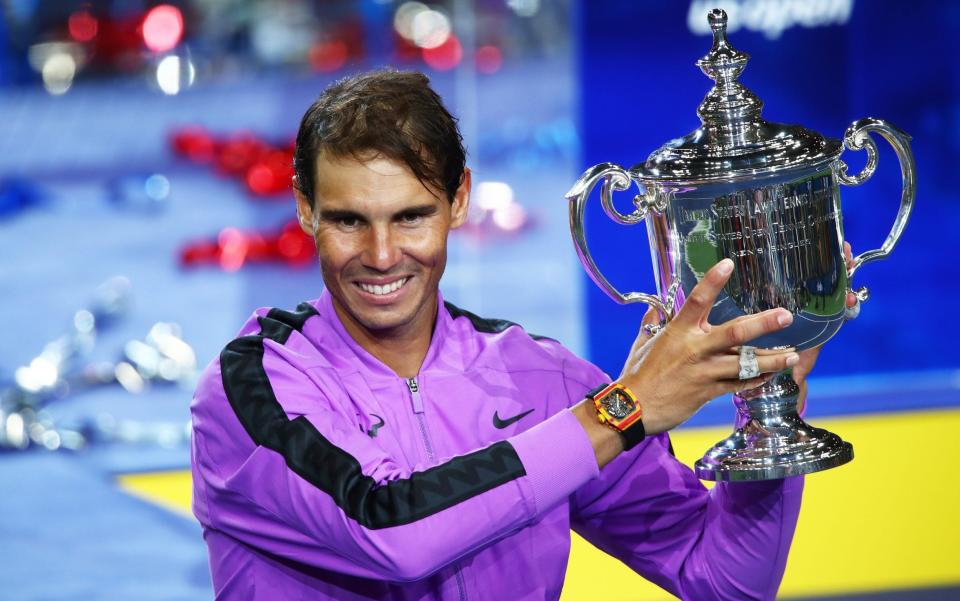Rafael Nadal wins US Open 2019: Is it possible to be an underrated 19-time major winner?

Should you ever dare to suggest to Rafael Nadal that a victory was straightforward, a couple of things will invariably happen. His left eyebrow will arch drastically upwards, he will exhale, and he will describe his latest 6-1, 6-1 thrashing as "very tough". Nadal may be arguably the greatest tennis player of all time, but he takes absolutely nothing for granted. He's the kind of person who even if his football team were 3-0 up in the 90th minute would still think they were going to draw.
Part of Nadal's anxiety about whoever he is playing is borne out of neurosis, but it also reflects the fact that in elite sport what looks straightforward is actually extremely difficult - and that minuscule lapses can have catastrophic effects.
Perhaps it is this ability to make superhuman achievements seem straightforward that explains why Nadal doesn't always get the recognition he deserves. It seems absurd to say about an 19-time major winner, but is Nadal a bit, well, underrated?
Let's start with Sunday night's US Open final, where Nadal managed to rouse himself from losing a two-sets lead to defeat the inspired young Russian Daniil Medvedev. On the face of it, the No 2 seed Nadal did what was expected of him and beat a lower-ranked and far less experienced opponent. In reality, Nadal produced some of the most resilient moments ever seen on a tennis court.
There were many to choose from, but one particularly stood out. Trailing 0-1 in the fifth set, having seen a two-sets lead evaporate, Nadal looked on the verge of collapse. After butchering a volley to fall down break point, Nadal went into full fidgeting mode - like a bored child being dragged around a museum. He reached for the towel, wiped the sweat away from his eyes, instinctively readjusted his headband and started bouncing the ball ready to serve. His nerves were such that for the second time in the match he was penalised for exceeding the allotted 25 seconds between points and so lost his first serve.
Extended video of Rafael Nadal watching the video montage to his 19 Grand Slams. pic.twitter.com/7seML9GjBN
— Nick Zaccardi (@nzaccardi) September 9, 2019
Nadal, the ultimate creature of habit, was being taken terrifyingly out of his comfort zone. The crowd booed, Nadal simply tossed the ball he was holding away, curved in a serve and then bulleted away a forehand to avert the danger. It was the sort of defiance that only the true greats are capable of, and the sort of moment that a glance at the final scoreboard can never convey.
It might be that Nadal needed a five-setter to remind people of how super-human his achievements are. Part of the problem with winning a frankly ludicrous, and never-to-be-repeated, 12 (TWELVE) French Opens is that it makes doing so almost seems normal. Remember that in the Open Era the closest anyone has come to this number is Bjorn Borg's six. That Nadal's title wins at Roland Garros tend to be so drama free and apparently easy - he has lost just three sets in his last 23 matches there - adds to a slight feeling of 'meh' around what he's done.
Nadal's dominance on clay also has the effect of leading some to mistakenly believe that he is a one-trick pony (which even if it were true would be a trick roughly akin to a pony doing a backflip while wearing roller-skates). In actual fact, even if you take away Nadal's 12 French Open titles, he still has seven majors to his name. That's more than the totals of Boris Becker and Stefan Edberg, the same as John McEnroe, and one fewer than greats like Andre Agassi, Jimmy Connors and Ivan Lendl. At the US Open, only Connors, Pete Sampras and Roger Federer have won more than Nadal's four titles in the Open Era.
That Federer is one of the three players above him on that particular leaderboard is significant, because it is Federer's enduring greatness that has partially masked Nadal's. Like an older brother, it's always been Federer doing everything first.
When Nadal won his first major at the French Open in 2005, Federer already had four of the things; when he completed the career Grand Slam in 2010, Federer had done it a year earlier; when he did a music video with Shakira, Federer was busy hanging out with Gwen Stefani.
In general, Federer's 16-year long lead over Nadal in the grand slam league table, allied to his more graceful style, has meant the latter perennially playing second fiddle in the GOAT (greatest of all time) race. You might be able to do a backflip while wearing roller-skates Rafa, but Roger can do the same while also wearing a monogrammed cardigan.
That Nadal is now just one major win behind his great rival - for the first time at the end of a slam since their tallies stood at 1-0 in 2003 - would surprise a lot of casual observers. Nadal has also now won more majors in his thirties than Federer, which is testament to his phenomenal endurance and powers of recovery. The failure of the 'Next Gen' of players to step up and challenge Nadal and Federer has been used as a way explain their and Novak Djokovic's ongoing dominance, but that too simply underlines the Big Three's mind-bending superiority.
For Nadal to be celebrated as the GOAT he will need to surpass Federer's grand-slam tally. But whatever the final numbers, he should be celebrated in isolation as among the greatest sportspeople of all time.
Anything less would be a gross under-estimation.

